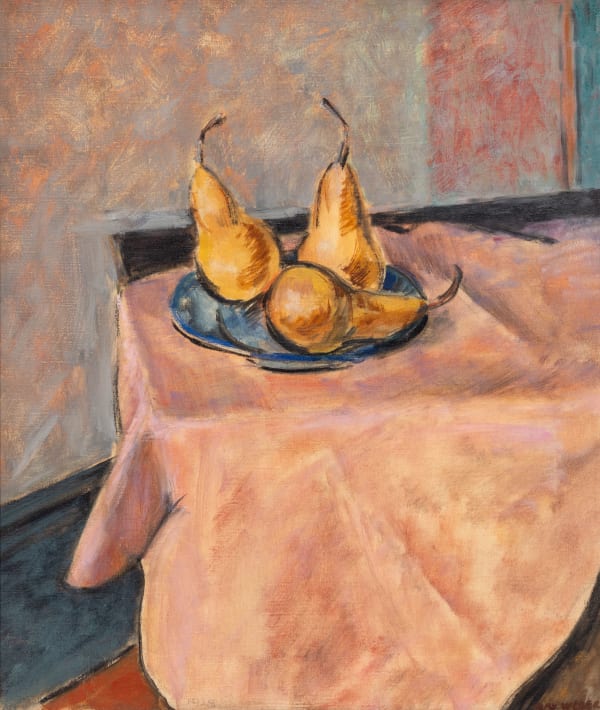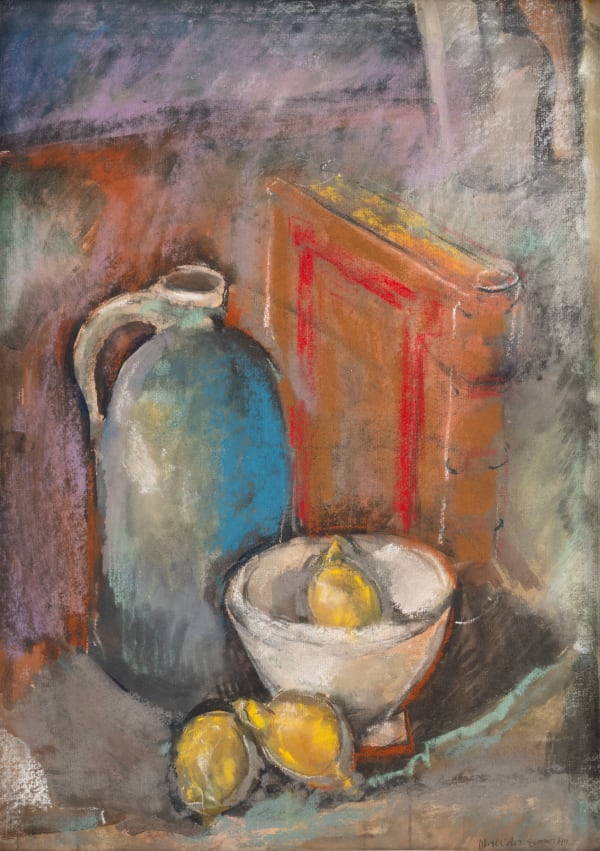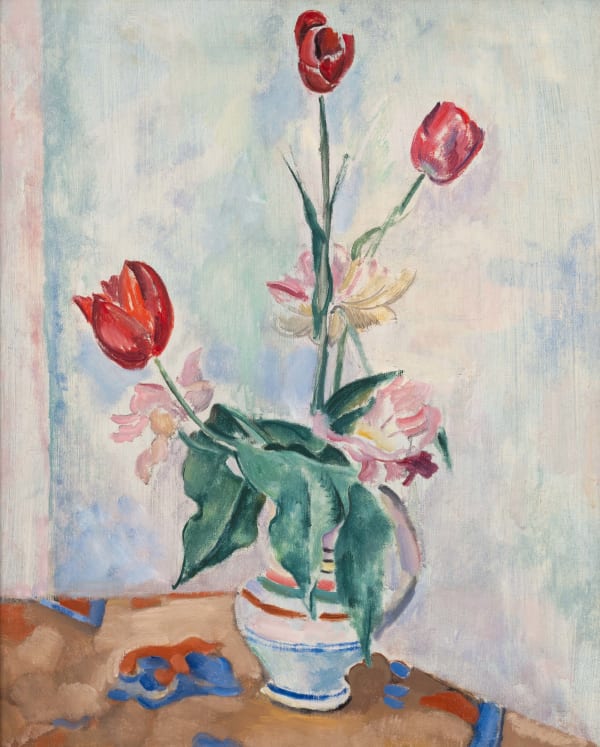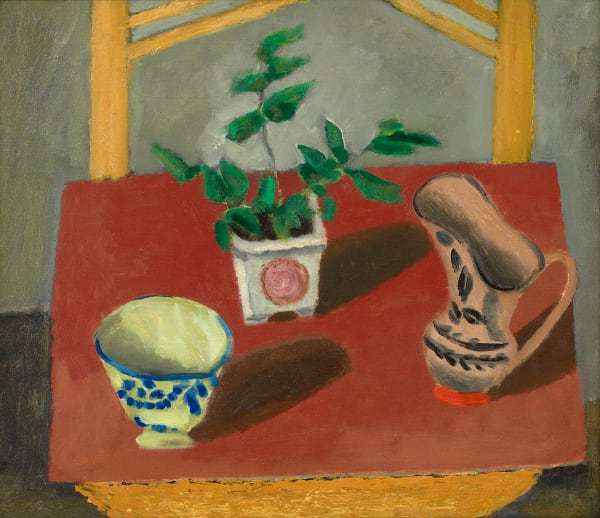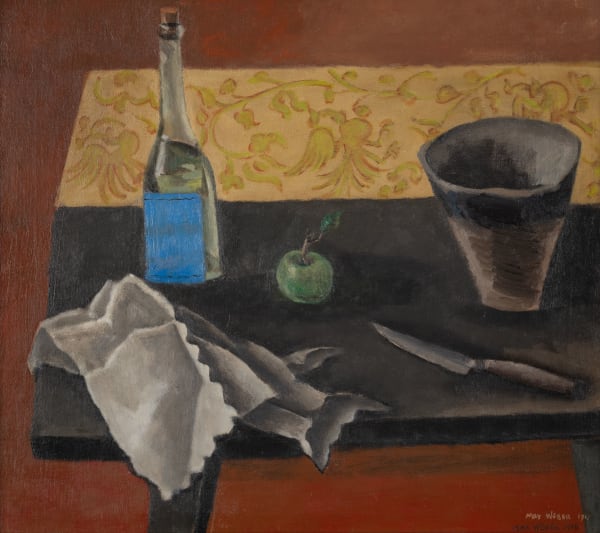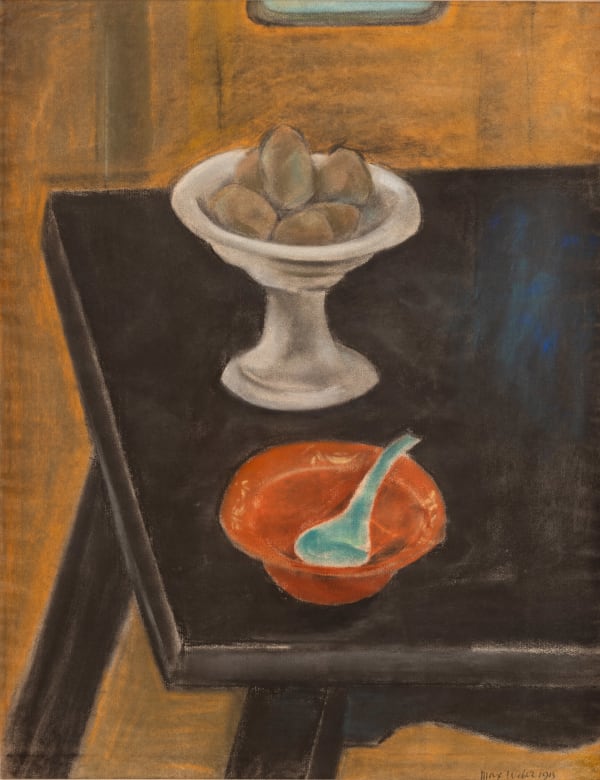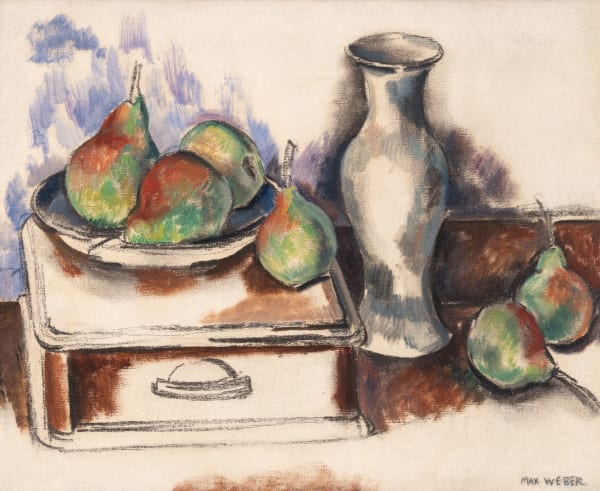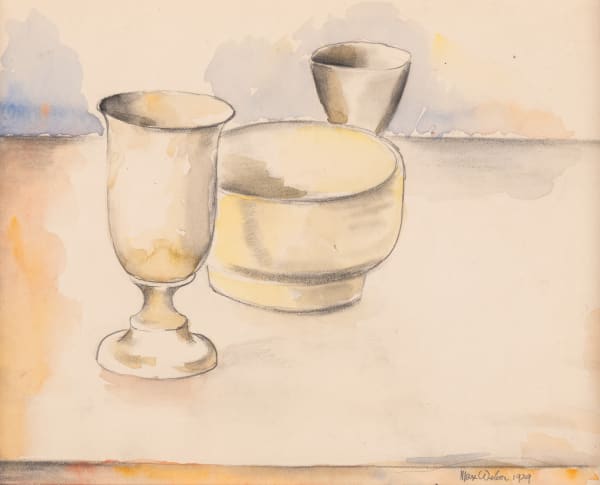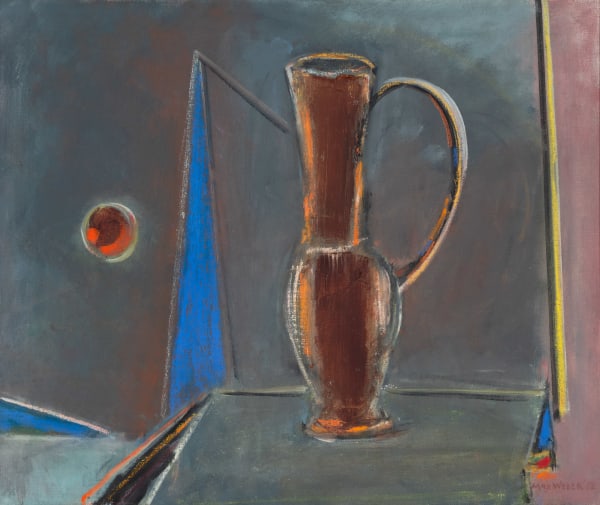Max Weber: Art and Life Are Not Apart presents 26 paintings and works on paper by Max Weber directly from the Max Weber Foundation spanning the full scope of the artist's career-long still life practice from 1907 to 1955. Informed by Paul Cézanne and Pablo Picasso, Weber's still lifes occupy a pivotal position between the European avant-garde and American modernism. The exhibition, which encompasses a variety of materials including oil, gold leaf collage, pastel, gouache, and watercolor, investigates Weber’s important contributions and reactions to a range of twentieth-century movements such as Cubism, Fauvism, and Surrealism.
In 1914, Weber claimed that “art and life are not apart,” positioning himself within a modernist tradition of painting quotidian life from lively Impressionist café scenes to hard-edge Pop depictions of mass-produced items. Weber distinguished himself through his deep belief that objects exist as symbols of culture and civilization and should be measured by their usefulness, spirituality, and intellect. According to Weber, culture is realized via the interaction between viewer and object. “Culture will come only when every man will know how to address himself to the inanimate simple things of life,” Weber wrote in his 1916 Essays on Art. “A pot, a cup, a piece of calico, a chair, a mantle, a frame, the binding of a book, the trimming of a dress…these we live with. Culture will come when people touch things with love and see them with a penetrating eye.” During the first half of the twentieth century, when many thinkers began to question the relationship between objects, images, and their meanings following the development of Saussurean semiotics, Weber remained committed to the concrete and tangible presence of objects rooted in the process of making. He believed the viewer could embody, through looking, the qualities of “proportion, harmony, balance, symmetry, in simple objects and works of art.”
In 1914, Weber claimed that “art and life are not apart,” positioning himself within a modernist tradition of painting quotidian life from lively Impressionist café scenes to hard-edge Pop depictions of mass-produced items. Weber distinguished himself through his deep belief that objects exist as symbols of culture and civilization and should be measured by their usefulness, spirituality, and intellect. According to Weber, culture is realized via the interaction between viewer and object. “Culture will come only when every man will know how to address himself to the inanimate simple things of life,” Weber wrote in his 1916 Essays on Art. “A pot, a cup, a piece of calico, a chair, a mantle, a frame, the binding of a book, the trimming of a dress…these we live with. Culture will come when people touch things with love and see them with a penetrating eye.” During the first half of the twentieth century, when many thinkers began to question the relationship between objects, images, and their meanings following the development of Saussurean semiotics, Weber remained committed to the concrete and tangible presence of objects rooted in the process of making. He believed the viewer could embody, through looking, the qualities of “proportion, harmony, balance, symmetry, in simple objects and works of art.”
-
 Max Weber1881-1961The Brass Candlestick, 1914Signed and dated at lower right: Max Weber 1914Gouache and gold leaf collage on paper24½ x 18¾ inches
Max Weber1881-1961The Brass Candlestick, 1914Signed and dated at lower right: Max Weber 1914Gouache and gold leaf collage on paper24½ x 18¾ inches
62.2 x 47.6 cm -
 Max Weber1881-1961Three Pears, 1929Signed at lower right: Max Weber; dated at lower center: 1929Oil on canvas21 x 18 inches
Max Weber1881-1961Three Pears, 1929Signed at lower right: Max Weber; dated at lower center: 1929Oil on canvas21 x 18 inches
53.3 x 45.7 cm -
 Max Weber1881-1961Still Life, c. 1917Gouache on paper12⅞ x 9¾ inches
Max Weber1881-1961Still Life, c. 1917Gouache on paper12⅞ x 9¾ inches
32.7 x 24.8 cm -
 Max Weber1881-1961Still Life with Blue Bottle, 1911Signed and dated at lower right: Max Weber Summer 1911Pastel and gouache on paper24½ x 19 inches
Max Weber1881-1961Still Life with Blue Bottle, 1911Signed and dated at lower right: Max Weber Summer 1911Pastel and gouache on paper24½ x 19 inches
62.2 x 48.3 cm -
 Max Weber1881-1961Abstract Still Life, c. 1914Inscribed at lower right by the artist's wife: MAX WEBER (FW)Pastel on paper21 x 17 inches
Max Weber1881-1961Abstract Still Life, c. 1914Inscribed at lower right by the artist's wife: MAX WEBER (FW)Pastel on paper21 x 17 inches
53.3 x 43.2 cm -
 Max Weber1881-1961The Pewter Cup, 1921Signed and dated at lower right: MAX WEBER 1921Gouache on paper on board14 x 10 inches
Max Weber1881-1961The Pewter Cup, 1921Signed and dated at lower right: MAX WEBER 1921Gouache on paper on board14 x 10 inches
35.6 x 25.4 cm -
 Max Weber1881-1961The Pitcher, 1911Watercolor on paper13⅞ x 10⅛ inches
Max Weber1881-1961The Pitcher, 1911Watercolor on paper13⅞ x 10⅛ inches
35.2 x 25.7 cm -
 Max Weber1881-1961Italian Pitcher, 1921Oil on canvas25⅞ x 31 inches
Max Weber1881-1961Italian Pitcher, 1921Oil on canvas25⅞ x 31 inches
65.7 x 78.7 cm -
 Max Weber1881-1961Still Life with Purple Leaves, 1912Signed and dated at lower right: MAX WEBER 1912Oil on canvas13¾ x 19¾ inches
Max Weber1881-1961Still Life with Purple Leaves, 1912Signed and dated at lower right: MAX WEBER 1912Oil on canvas13¾ x 19¾ inches
34.9 x 50.2 cm -
 Max Weber1881-1961The Green Bottle, 1907Oil on canvas18¼ x 15¼ inches
Max Weber1881-1961The Green Bottle, 1907Oil on canvas18¼ x 15¼ inches
46.4 x 38.7 cm -
 Max Weber1881-1961Three Tulips, 1908Oil on canvas22⅛ x 18 inches
Max Weber1881-1961Three Tulips, 1908Oil on canvas22⅛ x 18 inches
56.2 x 45.7 cm -
 Max Weber1881-1961Egyptian Pot and Fruit, 1923Signed at lower right: MAX WEBEROil on canvas30 x 25 inches
Max Weber1881-1961Egyptian Pot and Fruit, 1923Signed at lower right: MAX WEBEROil on canvas30 x 25 inches
76.2 x 63.5 cm -
 Max Weber1881-1961Chinese Planter with Green Leaves, c. 1907Oil on canvas18⅛ x 21⅛ inches
Max Weber1881-1961Chinese Planter with Green Leaves, c. 1907Oil on canvas18⅛ x 21⅛ inches
46 x 53.7 cm -
 Max Weber1881-1961The Blue Labeled Bottle, 1917-18Signed and dated twice at lower right: MAX WEBER 1917 / MAX WEBER 1918Oil on canvas21¼ x 24¼ inches
Max Weber1881-1961The Blue Labeled Bottle, 1917-18Signed and dated twice at lower right: MAX WEBER 1917 / MAX WEBER 1918Oil on canvas21¼ x 24¼ inches
54 x 61.6 cm -
 Max Weber1881-1961Still Life, 1913Signed and dated at lower right: Max Weber 1913Pastel on paper24½ x 18¾ inches
Max Weber1881-1961Still Life, 1913Signed and dated at lower right: Max Weber 1913Pastel on paper24½ x 18¾ inches
62.2 x 47.6 cm -
 Max Weber1881-1961The Drawer, 1921Signed at lower right MAX WEBEROil on canvas13¼ x 16⅛ inches
Max Weber1881-1961The Drawer, 1921Signed at lower right MAX WEBEROil on canvas13¼ x 16⅛ inches
33.7 x 41 cm -
 Max Weber1881-1961Colonial Table with Pitcher, c. 1942Signed at lower right: MAX WEBEROil on canvas36 x 28 inches
Max Weber1881-1961Colonial Table with Pitcher, c. 1942Signed at lower right: MAX WEBEROil on canvas36 x 28 inches
91.4 x 71.1 cm -
 Max Weber1881-1961Napkin and Apples, 1920Signed at lower right: Max WeberOil on canvas13⅛ x 16⅛ inches
Max Weber1881-1961Napkin and Apples, 1920Signed at lower right: Max WeberOil on canvas13⅛ x 16⅛ inches
33.3 x 41 cm -
 Max Weber1881-1961Still Life With Apples, 1928Signed at lower left: Max Weber; signed at lower right: Max WeberLithograph with pastel12⅜ x 16 inches
Max Weber1881-1961Still Life With Apples, 1928Signed at lower left: Max Weber; signed at lower right: Max WeberLithograph with pastel12⅜ x 16 inches
31.4 x 40.6 cmEdition of 50 -
 Max Weber1881-1961Lithography Plate for "Chinese Lion", 1932Signed with the artist's initials at lower left: M.W.Lithography plate10½ x 12 inches
Max Weber1881-1961Lithography Plate for "Chinese Lion", 1932Signed with the artist's initials at lower left: M.W.Lithography plate10½ x 12 inches
26.7 x 30.5 cm -
 Max Weber1881-1961Chinese Lion, 1932Signed with the artist's initials at lower left: M.W.; signed at lower right: Max Weber; stamped on verso with the artist's estate stamp: MWLithograph7½ x 8 ¾ inches
Max Weber1881-1961Chinese Lion, 1932Signed with the artist's initials at lower left: M.W.; signed at lower right: Max Weber; stamped on verso with the artist's estate stamp: MWLithograph7½ x 8 ¾ inches
19.1 x 22.2 cm -
 Max Weber1881-1961Lithography Plate for "Pewter Cup", 1928Signed in reverse at lower right: Max WeberLithography plate10 x 12 inches
Max Weber1881-1961Lithography Plate for "Pewter Cup", 1928Signed in reverse at lower right: Max WeberLithography plate10 x 12 inches
25.4 x 30.5 cm -
 Max Weber1881-1961Pewter Cup, 1928Signed at lower left: Max Weber; signed at lower right: Max Weber; stamped on verso with the artist's estate stamp: MWLithograph8⅜ x 9⅝ inches
Max Weber1881-1961Pewter Cup, 1928Signed at lower left: Max Weber; signed at lower right: Max Weber; stamped on verso with the artist's estate stamp: MWLithograph8⅜ x 9⅝ inches
21.3 x 24.4 cmEdition of 30 -
 Max Weber1881-1961Pewter Cup, 1929Signed and dated at lower right: Max Weber 1929Watercolor and pencil on paper7½ x 9½ inches
Max Weber1881-1961Pewter Cup, 1929Signed and dated at lower right: Max Weber 1929Watercolor and pencil on paper7½ x 9½ inches
19.1 x 24.1 cm -
 Max Weber1881-1961Lithography Plate for "Still Life with Apples", 1928Signed in reverse at lower left: Max WeberLithography plate14⅛ x 18 inches
Max Weber1881-1961Lithography Plate for "Still Life with Apples", 1928Signed in reverse at lower left: Max WeberLithography plate14⅛ x 18 inches
35.9 x 45.7 cm -
 Max Weber1881-1961Still Life, 1949Signed at lower right: MAX WEBER '49Gouache, gold leaf collage and graphite on paper mounted on board5¼ x 4⅞ inches
Max Weber1881-1961Still Life, 1949Signed at lower right: MAX WEBER '49Gouache, gold leaf collage and graphite on paper mounted on board5¼ x 4⅞ inches
13.3 x 12.4 cm -
 Max Weber1881-1961Yellow Pitcher, 1955Signed and dated at lower right: Max Weber '55Pastel and gouache on paper mounted on board18 x 24 inches
Max Weber1881-1961Yellow Pitcher, 1955Signed and dated at lower right: Max Weber '55Pastel and gouache on paper mounted on board18 x 24 inches
45.7 x 61 cm -
 Max Weber1881-1961Flowers, 1944Signed and dated at lower right: MAX WEBER '44Oil on canvas30¼ x 25¼ inches
Max Weber1881-1961Flowers, 1944Signed and dated at lower right: MAX WEBER '44Oil on canvas30¼ x 25¼ inches
76.8 x 64.1 cm -
 Max Weber1881-1961Brown Pitcher, 1953Signed and dated at lower right: MAX WEBER '53Oil on canvas20⅛ x 24¼ inches
Max Weber1881-1961Brown Pitcher, 1953Signed and dated at lower right: MAX WEBER '53Oil on canvas20⅛ x 24¼ inches
51.1 x 61.6 cm


